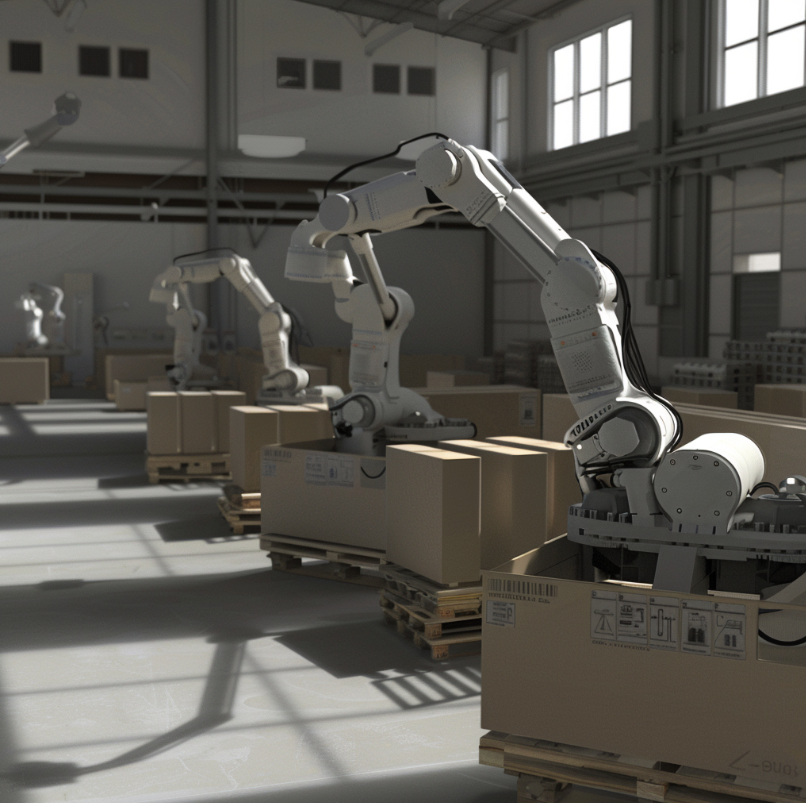

Cobot Palletizing robots, or Cobots, mark a tremendous change in the robotics landscape, blending seamlessly into human-centric workspaces.
They're equipped with sophisticated sensors and soft-touch mechanisms that allow them to detect and adapt to their human colleagues' presence, helping make sure operations are both efficient and injury-free.
Of course, this is not something to be trusted blindly, and humans are still expected to follow safety measures around Cobots. Don’t go putting your head close to one, is all we’re saying.
Their design philosophy centers around harmony between man and machine, fixing the need for the isolating cages that once defined industrial robotic workstations.
The idea is to foster a more integrated production environment where Cobots and humans can share tasks and spaces without the physical barriers that traditionally segmented workflows.
Cobot Palletizers offer quite a few benefits over traditional, old-school palletizers.
They are:
A Cobot Palletizer unit typically ranges from $50,000 to $100,000 or more, depending on the specific arm selected and other components you need for your application.
The Cobot arm itself typically makes up $2,000 to $75,000 of the total cost.
Arms like Techman's TM Robot, OnRobot's Gecko Gripper, and FANUC Cobots are on the higher end, while Standard Bots’ RO1 and Doosan Robotics' M1013 are more budget-friendly but high-quality options.
You'll also need to factor in the cost of integrating the Cobot into your production line.
While most Cobots can work with humans some need protective measures, including safety equipment like light curtains, emergency stops, and fencing.
This additional equipment usually adds at least $10,000 to $30,000 to the total cost. Some Cobots may require even more extensive guarding and safety controls based on your specific layout and application.
Most Cobots are programmed using intuitive software with drag-and-drop functionality, but you'll still need someone to properly program the robot and test the application.
Expect to pay a few thousand dollars for initial programming, plus additional costs for any major changes needed down the road.
The good news? Some Cobots now operate on no-code frameworks, making setting them up easier – and cheaper.
Finally, give some serious thought to installation and training fees, which typically range from $5,000 to $15,000 or more depending on the complexity of your setup.
Now, most Cobot manufacturers and distributors offer installation and training services to help get your new robot up and running as efficiently as possible.
As we said: while the upfront cost of a Cobot Palletizer may seem sky-high, many manufacturers find that Cobots can pay for themselves in just 1-3 years through the trifecta of increased productivity, improved safety, and labor savings.

Now, it’s time to roll out the red carpet. These are the five Cobot Palletizer robots you need to have on your radar.
They are:
Cool factor: RO1 is compact and modular, fitting seamlessly into tight spaces – and doesn’t require you to overhaul your shop floor. Plus, its quick-change tooling (compatible with major brands such as OnRobot) handles diverse loads efficiently.
Cool factor: Vention boasts impressive flexibility, offering single or dual-pallet configurations and adaptable bases for various production lines.
Cool factor: Minipal + shines in tight spaces with its small footprint and lightweight design, with very high repeatability for more precise palletizing.
Cool factor: The PalletizCRX has a very quick deployment and no safety fencing, making it a plug-and-play palletizing solution that doesn’t need extensive shop floor modifications.
Cool factor: The Swifti CRB 1300 combines a sleek design with intuitive programming, making it ideal for first-time Cobot users.
Cobot Palletizers can range from $2,000 up to $100,000 or more, depending on the model and features. The arm itself typically makes up about half the cost. You’ll also need to factor in other expenses like integration, safety mechanisms, and conveyors. Many manufacturers offer financing and leasing options to help make Cobot Palletizers more affordable.
Cobot Palletizers are designed to be easy to program, even for operators without an engineering background. Most Cobot manufacturers provide intuitive software that allows you to simply “teach” the Cobot by moving its arm through the desired palletizing motions. The Cobot will then repeat those motions when running automatically.
Some Cobots can even be programmed through a tablet or smartphone. Re-programming a Cobot for a new product or pallet pattern only takes a few minutes.
Cobot Palletizer speed depends on the specific model and your application. In general, Cobots can palletize 200 to 500 cases per hour. While not as fast as a high-speed conventional Palletizer, Cobots make up for it in flexibility, ease of use, and low cost.
Their speed is also increasing over time with continued improvements in Cobot technology. For many operations, a Cobot can palletize fast enough to keep up with production demands.
Yes, Cobots are designed to work safely alongside human workers. They have built-in safety features like force-limited joints, emergency stops, and sensors that detect when a person is nearby. This allows Cobots and humans to work in close proximity without cages or barriers.
However, proper safety precautions should still be followed, like training workers on how to operate with Cobots and demarcating Cobot work areas.
Cobot Palletizers are used in a variety of industries like food and beverage, consumer goods, logistics, and warehousing. Companies of all sizes, from small craft producers to major manufacturers, are adopting Cobot Palletizers.
Cobots handle everything from cases of beer and boxes of tissues to crates of vegetables and pallets of packaged meats. Their flexibility and easy redeployment mean one Cobot can often handle multiple different products.
Now, you’re armed (pun intended) with the five best Cobot Palletizer robots that are going to completely revamp the way you handle palletizing in 2024.
With flexible, user-friendly options like Standard Bots’ RO1 and Minipal+ or heavy-duty choices like the FANUC CRX, there’s something for everyone, and especially, every budget!